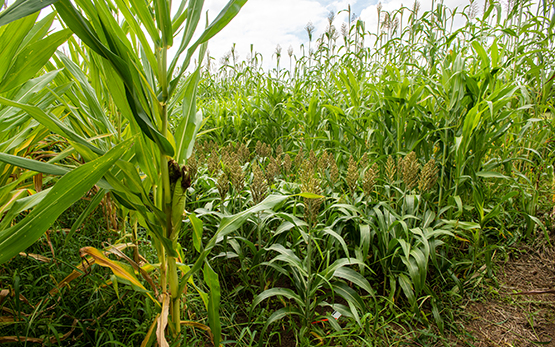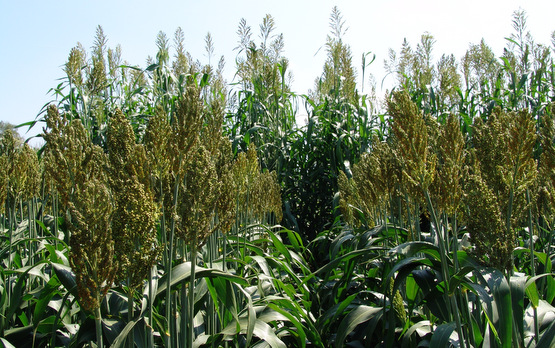Agroscope’s trials test the agronomic properties of sorghum, an African grass from the family Poaceae, and its qualities as a forage.
The recent hot spells have turned many forage fields at Agroscope’s Posieux site yellow. Not so, however, those planted with the forage plant sorghum, which remain a vibrant green.
In drought years such as 2022, grass and maize growth declines drastically, especially in the months of July and August. This can lead to significant forage shortages, which impact the year’s reserves. Sorghum has great potential for offsetting this shortage and guaranteeing the availability of forage during these dry periods, as well as in winter as conserved forage. Fodder sorghum’s drought tolerance and high yields make it a potentially important food source for ruminants.
Mixtures improve fodder quality
Certain varieties of sorghum produce large amounts of biomass but are generally of relatively low nutritional value. Sorghum was therefore sown in Posieux in combination with various fodder plants such as crimson clover (Trifolium incarnatum), Egyptian clover (Trifolium alexandrinum) and Westerwold ryegrass (Lolium multiflorum Lam. Var. westerwolidicum Mansh.) with the aim of increasing the energy and protein content of the forage, its flexibility of use, and its ability to withstand extreme weather fluctuations.
Multicut fodder sorghum tested in Posieux
Since there are distinct differences between the varieties, five different sorghums are being tested this year as to their agronomic characteristics and nutritional value. Moreover, in its juvenile stage sorghum contains hydrocyanic acid, which can be dangerous for ruminants in too-high concentrations. It is therefore important to compare the varieties to determine their differences in this respect. Chemical analyses will also investigate the quality of the different varieties as conserved forage. Agroscope plans to conduct grazing trials with sorghum in the near future, but only with plants at the advanced vegetative stage and above 80 cm in height, in order to avoid problems with hydrocyanic acid. A further trial will determine the organic-matter digestibility of multicut sorghum to allow an estimation of its nutritive value for ruminants.
Single-cut fodder sorghum tested in Zurich
In addition to multicut varieties, single-cut sorghum varieties underwent intensive testing, with researchers recording agronomic characteristics such as yield, dry-matter content and resistance to lodging. They also examined the quality of the constituents and developed a calibration for assessing fodder value. Based on trials conducted to date, sorghum is viewed as a promising plant that, owing to its characteristics, has potential for succeeding in Switzerland.
Map to show possible cultivation areas
Since sorghum is somewhat more demanding than maize in terms of temperature, another project aims to show on a map of Switzerland regions suitable for the cultivation of grain and silage sorghum.







